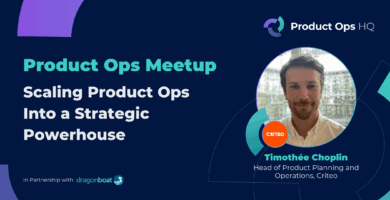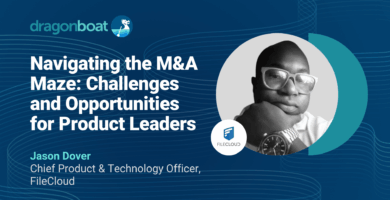Events • On Demand | Watch Time: 57 Min
Q&A with Melissa Perri: Driving an Outcome Oriented Product Strategy
What makes a good product manager, and why are so many organizations now taking an outcome-focused approach? Melissa Perri and Becky Flint dive into product management best practices, what’s actually needed to run an outcome-focused product team successfully from the right processes, structure, and tools, and how you can use data to inform strategy to ensure insights are being communicated across the entire organization.
Key Highlights:
- Product management best practices- what makes good product management
- The meaning of outcome-focused and the common misconceptions
- Differences, focus, and mindset for product leaders transitioning into Chief Product Officer (CPO) roles
- The processes, structures and tools needed to be an outcome-driven product organization
- Advice for product managers playing hybrid roles as directors of product in smaller organizations
- Why Melissa Perri joined Dragonboat’s board of advisors
This conversation was taken from Melissa’s keynote speech at the Dragonboat ProductCon 2022 expo booth. Watch the full webinar below and read on for key takeaways and the audience Q&A.
Product Management Best Practices – What Makes Good Product Management?
Melissa Perri has worked with dozens of companies across all industries, sizes, and growth stages. Below are a few of her core beliefs about what makes successful product management.
Optimizing The Value Creation System
There are two pieces of the system: customers on one side that need customer value, and businesses that provide value to customers through products and services. Product managers need to figure out how to optimize both pieces (optimizing customer value and in return, getting business value).
Successful product managers have:
- A deep understanding of their customers
- Alignment on their business goals and ability to see how they’re tracking towards those goals
- Tight feedback loops to understand what’s going on across the organization
Understanding That Product Management is a Business Role
There is a common misconception that product management is a tech or IT role when in reality it is, and should be viewed as, a business role.
“Product managers are there to further the business through software, and there is no company today that can do without that, every company at the end of the day comes back to software to reach business outcomes. Good product managers look at those software opportunities and how they can drive business value.”
Melissa Perri
Seeing and Utilizing Software as a Core Piece of Your Business Strategy
In today’s market, organizations need to see software as a core piece of their strategy. Even traditional organizations like banking and insurance have begun to make the shift because they need to build products rapidly, understand their customers, and are able to produce modern products in a world where people need software to achieve business goals.
“Software is a business strategy, not just an IT strategy, it’s not about saving costs, it’s really about delivering maximum value to your customers in ways that we could never do before.”
Melissa Perri
What Does Outcome-Focused Mean and What Are the Common Misconceptions?
Increasingly, product professionals are talking about the shift to outcome focused. Below we breakdown what being an outcome-focused organization means, the common misconceptions, and how organizations can be successful.
Outcomes vs Outputs
“You need outputs to get to outcomes so you can’t forget about outputs. The whole idea about outcome-focused product management is that the outputs are a means to an end where they produce an outcome. If you’re not keeping an eye on what you’re trying to achieve with a feature or product, it’s easy to get caught in the build trap.”
Melissa Perri
There is a common misconception that outcome-focused product organizations only focus on outcomes, but the outputs are needed to reach those outcomes. The key difference is that outcome-focused organizations, in addition to ensuring delivery, also need to:
- Have an understanding of business goals
- Evaluate how those goals can be achieved through helping customers achieve their goals
- Tie that strategy together and monitor progress towards outcomes
“It doesn’t matter what we ship as long as it achieves goals.”
Melissa Perri
Differences, Focus, and Mindset for Product Leaders Transitioning into CPO Roles
While Product Managers often think in terms of prioritization, Product Executives and Chief Product Officers need to shift their mindset towards allocation, financial resources, and business objectives to move forward.
A product manager typically has three different skill sets:
- Tactical– Focusing on how to build and deliver products, working closely with developers to push a feature or product live
- Strategic– Understanding where you’re going with a long-term thinking mindset, and how to achieve product vision and drive the product portfolio towards that vision
- Operational– Connecting the tactical and strategic with a focus on how to move the tactical to strategic through roadmaps and cross-team communication
“When you’re a team level product manager, often you’re 90% tactical, but need to be strategic and operational to make sure that you’re building the right products and being forward thinking. If you’re not practicing your strategic level skills it can become a barrier to getting to the next level.”
Melissa Perri
At the next level, a VP of Product is often split 50/50 between strategic and tactically and is often in charge of coaching and expanding the team, and managing the roadmap for at least one product line. Chief Product Officers however, often oversee a portfolio of products and need to have business-focused goals, a deep understanding of the financials of the business, how to increase revenue, and how different strategies will help achieve those goals.
“A CPO is at the executive level and needs to understand the gaps, design the strategy and enable themselves with enough data to get answers and drive results. It’s such an important role for any organization that uses software as you can make or break the business strategy.”
Melissa Perri
When transitioning from VP of Product to Chief Product Officer there needs to be a shift from the tactical (what are we building) and an understanding that your first team is no longer your product people and is now the rest of the executives. Chief Product Officers need to focus on working closely across the organization including building relationships across departments, including with the CRO and CMO to bring them together with product.
Do You Have Advice for Product Managers Playing Hybrid Roles as Directors of Product in Smaller Organizations?
As we discussed before, many of the key shifts in focus and mindset for transitioning into a CPO role will help product managers move into director-level roles including, thinking more commercially and financially, demonstrating strategy, coaching the team are all key areas to focus on during a transition up the organization.
As a director of product you’ll need to be a lot more operational and tactical and are likely responsible for putting together product roadmaps, pulling in data to make sure your team can make data-driven decisions and enabling them with everything they need to be successful.
“One of the key components to this is cross-functional collaboration. Working with the entire organization is key to doing the job well. As product leaders, you need to get everybody on board as you are the steward for the outcome, and if the product is producing the outcome you need to be the evangelist for it. You need to get a deep understanding of the goals of the people around you and bring together everybody in the organization to move forward.”
Melissa Perri
What Processes, Structures and Tools are Needed for an Outcome Driven Product Organization?
As more and more organizations shift from traditional feature based to outcome focused, there are key differences in the processes, structures and tools needed to become an outcome driven product organization.
Traditionally, most organizations will start with engineering tools like Jira to get an understanding of the work in progress, but then there tends to be a gap in how we tie all these working items into the overall strategy.
- Have we given the product team the tools and support they need to be successful?
- Have we adapted, changed, or implemented efficient processes that removed points of friction?
- Do the product managers have visibility and feel empowered that their work is contributing to the overall success and goals of the organization as a whole?
“That’s why I got really excited about Dragonboat so that we can tie all of the things we’re working on into what we’re achieving as a strategy.”
Melissa Perri
Create a System Where You Can Track Progress Overtime Against Different Key Metrics
To become a successful outcome-focused organization, companies need to connect data from all their different systems; connecting Jira to monitor OKRs, pulling data from financials to track revenue and cost outcomes, pulling together win/loss analysis statistics from sales and customer services so that you have one centralized system and place to track the progress over time against a variety of key metrics.
What’s Your Experience with Various Products and Why Did You Get Behind Dragonboat?
Melissa Perri has worked across a variety of teams and has exposure to dozens of tools and processes, so why did she ultimately get behind Dragonboat on the Board of Advisors?
“In the past when working to set strategy, we couldn’t get the data needed to make the decisions. Managing the portfolio lines became really difficult, and reconciling what was going on against our goals was challenging. We needed help to make decisions in real-time as an executive team, which is why I got so excited about Dragonboat. Everyone needs transparency and visibility across the portfolio so Dragonboat solves so many problems for senior leadership teams by giving them that real-time visibility into what’s going on and how close we are to achieving our goals.”
Melissa Perri
Audience Q&A
Do You Have Recommendations for How to Get Alignment With Senior Leadership That Are Averse to Product Operations?
A product manager’s job is to make strategic decisions about how to deliver value for users and not to pull the data to make those decisions. Successful product operations teams enable product managers with the tools and systems needed to do their job well and optimize customer value and business value.
“Product Operations is there to enable strategic decision making. The number one reason why I hear product managers can’t talk to customers or be more outcome-focused is because they don’t have time. They’re spending time on recruiting user researchers, answering questions from developers, and gathering data to make decisions. This means that the organization was not set up well to distribute data to the product manager to make those informed decisions, there isn’t the right cadence for reviewing strategy, or standardized templates that allow you to communicate your product roadmap and strategy, and that’s what product operations is there to help with.”
Melissa Perri
How Do You Convey The Value of Kickstarting Product Operations Within an Organization?
There are a few key areas that product operations cover and help solve; getting data to make informed decisions, streamlining user research to gain a deeper understanding of customers, or putting systems, processes, and tools into place. When kickstarting product operations you should start by understanding the biggest pain points within your company first.
In Order to Have a Product-Led Organization Do You Need a CPO?
While some organizations can have product teams report into a CTO or similar role, it can be a challenge if the CTO doesn’t understand the product dynamic. In a typical product-led organization you have the CEO setting the company vision and the business strategy, the CTO setting the technical strategy, and the CPO ensuring that all the software that you develop and build brings all your commercial activities to life.
“Most CTOs don’t think commercially about how the software is going to manifest and add revenue, reduce cost, project revenue, and all those strategic parts, and that’s what the CPO is there to do. The CPO is there to help the CTO bring those visions to life”.
Melissa Perri
How Would You Describe the Value of Dragonboat to Product Managers?
Dragonboat is built as a tool for the entire product organization, and no matter your role within the product organization, it can be used to gain valuable insights that enable you to do your job more effectively.
For product managers, Dragonboat provides extra context into how your work contributes to the larger organizational goals.
“Even as a first-time Product manager, you need to understand how we contribute to the strategy and that’s what Dragonboat helps you do. It gives you the understanding of how all the things you’re working on ladders up into the bigger company goals and how that looks across the portfolio. Even if you’re not making those strategic decisions about what to start and stop, you need to understand how you fit into the picture and that’s where Dragonboat is really helpful“.
Melissa Perri
For product leaders, Dragonboat provides visibility into your product portfolio and gives you the data and insights to make strategic decisions.
As a product leader, I need to be making those strategic decisions about what to start, stop or change, and how I can allocate resources, and that’s where Dragonboat helps by giving me full visibility into my portfolio and how it contributes to the success of the company and making it transparent for the entire organization”.
Melissa Perri
How Would You Convince Upper Management to Become More Product-Led?
Typically selling upper management on a concept or trend doesn’t translate well or help move you in the right direction toward becoming product-led. Instead product leaders should look into the organization and company goals to identify the gaps in strategy, technology, or processes to figure out what isn’t working and demonstrate how good product practices can help solve those problems.
“Upper management doesn’t care about product, they care about reaching their business goals, so you need to explain how product helps them reach their business goals and how product-lead reaches those business goals”.
Melissa Perri
What Can Product Teams Do to Ensure There is More Balance Between Engineering and Product?
“Sometimes we need to put engineering under the CTO and that happens when engineering is leading the product roadmap and not the other way around which is product leading the engineering roadmap and we always want to have the second scenario in a product-led organization”.
Melissa Perri
Which Types of Tools Do You View as Essential to Product Management?
Besides tools like Dragonboat and general roadmapping tools, a ticket management system like Jira is core to a product organization.
“One of the biggest things I’ve learned is you need to be able to get the data out of the system and dump it into different systems, and that’s why many teams adopt Jira to start with, there also needs to be some alignment across tools so that a CPO has visibility in one centralized place”.
Melissa Perri

Featured Speakers

Becky Flint
Founder and CEO of Dragonboat
Becky is a product and tech executive based in the Silicon Valley. She has built and scaled product and engineering teams globally for both startups and Fortune 500 companies. Currently Becky is the Founder and CEO of Dragonboat with a mission to empower responsive leaders and their teams to build better products faster. Prior to founding Dragonboat, Becky has held executive roles at Feedzai, Bigcommerce, Tinyprints/Shutterfly, and PayPal.

Melissa Perri
CEO, Produxlabs & Author of Escaping the Build Trap
Melissa Perri has worked with dozens of companies across all industries, sizes, and growth stages.


